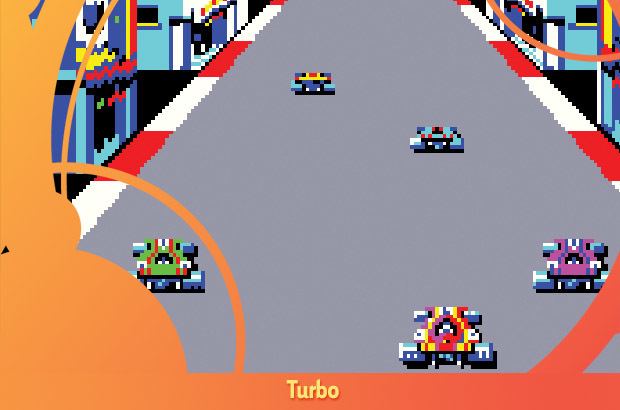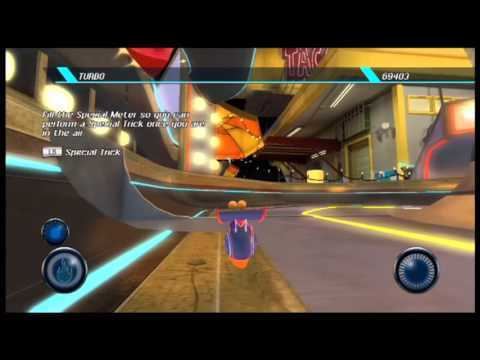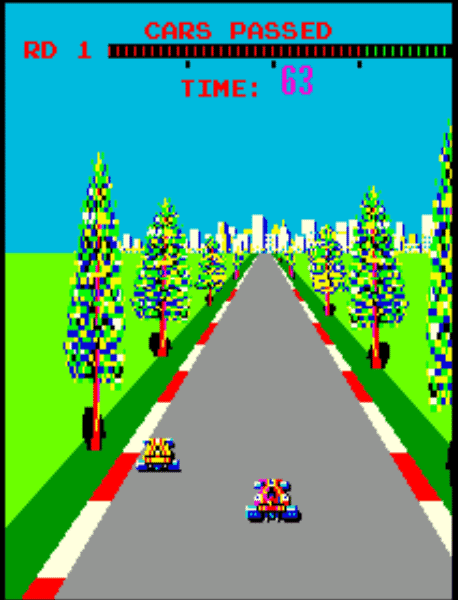Designer(s) Steve Hanawa Cabinet Standard and Sit-down Initial release date October 1981 Mode Single-player video game | Genre(s) Arcade-style racing | |
 | ||
Similar Al Unser Jr's Turbo Racing, Super Street Fighter II, Street Fighter II′ Turbo: Hy, Hot Wheels Turbo Racing, Super Street Fighter II | ||
Turbo (ターボ) is a racing game released in 1981 by Sega. It was one of the most popular arcade games of 1981.
Contents

The game was manufactured three formats: standard upright, cabaret/mini, and a seated environmental/cockpit. All three versions feature a steering wheel, a gearshift for low and high gears, and an accelerator pedal. The screen is a vertically oriented 20-inch raster display. In addition to the on-screen display, Turbo features an LED panel to the left of the screen that displays the current player's score and the high score table. Turbo also features lighted oil and temperature gauges on either side of the steering wheel.

Turbo was ported to the Colecovision and Intellivision home consoles.
Gameplay

Turbo requires the player to navigate a road race through different urban and rural locations, through differing weather conditions, and during changing times of day. The cars in the game resemble Formula 1 race cars. In order to proceed, the player must pass and stay ahead of at least 30 competing cars before time expires. Some opponents drive predictably, while others swerve across the road suddenly.

In the first round, the player has unlimited lives; collisions with other vehicles will return the player's car to the starting line. In subsequent rounds, the player is limited to three lives, and awarded an additional life (up to a total of four) for each completed round. In addition to competing racers, an ambulance occasionally comes along from behind and overtakes the player - they must be avoided, as contact with them will cause the player to lose a life; the game will be over when all player lives are gone.
Development

Turbo was designed and coded by Steve Hanawa. In an interview, Hanawa stated that despite its historical significance as a precedent-setting racing video game, he considers the process of creating it to have been his worst development experience at Sega. Development of Turbo required such a difficult and protracted schedule of coding and debugging that he was hospitalized for a month following its completion due to stress, exhaustion and a spontaneously collapsed lung.
Legacy
Turbo set many precedents in racing video game design, several of which are still standard today. Turbo was the first full-color raster display racing game to feature the now common third-person perspective, rear-view racer format, the first third-person racing game to feature scaling sprites of competing AI drivers, trees, and cityscape elements (including skyscrapers as tall as the screen), the first third-person racing game to feature multiple landscapes (cities, countrysides, seasides, bridges, and tunnels), as well as the first racing game to feature different times of day and different weather conditions (clear weather and snow). Turbo was also the first third-person racing video game to feature hills in its race course.
An Atari 2600 port by Coleco was in development and advertised by Coleco and, but it was never completed, due in part to the lead programmer, Michael Green, having been struck and seriously injured by a drunk driver while riding a bicycle. The prototype, estimated to be about 80% complete, was found by another Coleco programmer, Anthony Henderson, in his attic in 2006.
A Turbo board game was released by Milton Bradley in 1983.
Reception
The arcade version of Turbo was reviewed by Computer and Video Games magazine's July 1982 issue. They praised the "Realism", controls, "marvellous graphical capabilities" and the "variety of backgrounds and racing conditions on the screen."
Turbo was reviewed by Video magazine in its "Arcade Alley" column where it was hailed as "the king of the video road". The ColecoVision version was praised for the effort that had gone into replicating the visuals of the original arcade version, with reviewers making special note of the varied, non-repetitive backgrounds that enticed players to play in order to see "never-before-seen play scenes". Reviewers also commented favorably on the realism-enhancing use of steering wheel, gas pedal, and gear shift peripherals.
Arcade Express reviewed the ColecoVision version in January 1983 and scored it a perfect 10 out of 10, remarking that the "king of the coin-op driving games arrives in the home market". They stated that while it isn't "as graphically arresting as the" arcade version, it "comes reasonably close to matching the multi-scenario brilliance" and "the special control panel lifts this cartridge to greatness."
In popular culture
The upright cabinet of Turbo is seen in Rainbow's video for "Death Alley Driver."
Turbo was featured in the film Koyaanisqatsi.
It might have also been the inspiration for the fictional video game "Turbo Time" in the Walt Disney film "Wreck-It Ralph."
